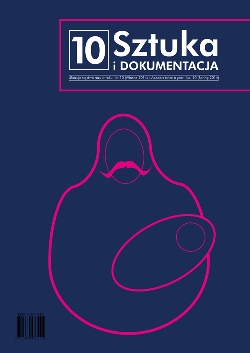Transforming Spectators Into Witnesses: Artur Barrio’s Bloody Bundles
Transforming Spectators Into Witnesses: Artur Barrio’s Bloody Bundles
Author(s): Camila MarojaSubject(s): Fine Arts / Performing Arts
Published by: Akademia Sztuk Pięknych w Gdańsku
Keywords: Artur Barrio, Bloody Bundles
Summary/Abstract: In 1969 Artur Barrio created what he termed “T.E.” (trouxas ensangüentadas) or Bloody Bundles: “objects” consisting of blood, cow meat, paper, and rope tied together with cloth. Essentially ephemeral, with raw meat and blood staining the wrapping cloth and producing a distinctively pungent odor, he used these highly evocative objects in three performances in 1969-70, calling the action/installation a situation. Although the artist originally installed the Bloody Bundles in a museum gallery, he subsequently moved them into public spaces. Deposited throughout a city, the Bloody Bundles would accost and upset the daily routines of unsuspecting viewers. When thinking about the provocative use of such non-aesthetic, disturbing materials, it is important to remember that, in 1964, Brazil was the first of many countries in South America to suffer a coup-d’état. During Brazil’s subsequent twenty-one years of dictatorial rule, some eighteen million people were denied rights, sixty thousand were arrested, 203 were killed, and 136 “disappeared,” all crimes hidden from public view by state censorship. This essay analyzes the situations Barrio realized with his Bloody Bundles in relation to Brazil’s violent history. As the crimes committed by the military were perpetrated in secrecy, I employ the concept of “hiddenness” as a metaphor for the dissociation of the Brazilian people, which blurred their sense and perception of the event and image they were experiencing. I propose that Barrio’s public interventions with Bloody Bundles reenacted a form of this dissociated knowledge and fear of state terror, and that they also functioned to transform viewers into victims and witnesses of their historical situation. In so doing, I argue that the Bloody Bundles constitute the visual, material presence for the otherwise invisible violence of Brazilian history, especially for its missing political prisoners. At the same time, Barrio’s Bloody Bundles also belong to the aesthetic and art historical context of early conceptual, performance, and installation art, and cannot be reduced to a narrow reading of political history. Moreover, the Bloody Bundles stood as Barrio’s strategy to actuate himself not only as an emerging avant-guard artist at the time, but also as a critical citizen.
Journal: Sztuka i Dokumentacja
- Issue Year: 2014
- Issue No: 10
- Page Range: 23-29
- Page Count: 7
- Language: English

